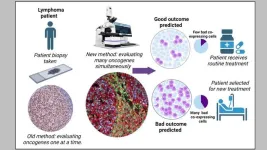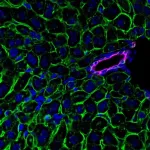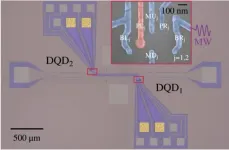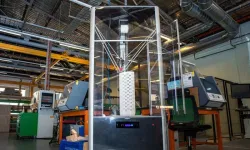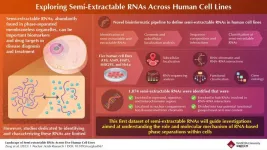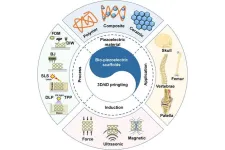(Press-News.org) A team of researchers from the Cancer Science Institute of Singapore (CSI Singapore) at the National University of Singapore (NUS), led by Assistant Professor Anand Jeyasekharan, has discovered a unique combination of oncogenes that could predict treatment resistance, and hence unfavourable outcomes, of patients with Diffuse large B cell lymphoma (DLBCL), the most common type of blood cancer in Singapore and globally.
This unique oncogenic combination, serving as an indicator of treatment resistance, can be detected through state-of-the-art technology. The researchers, however, went a step further to develop a simple mathematical formula that can predict the fraction of cells with this unique unfavourable combination from information obtained through established diagnostic methods – paving the way for this oncogene indicator to be used in routine clinical practice.
Their findings were published in Cancer Discovery, the flagship journal of the American Association of Cancer Research (AACR), on 4 May 2023.
Understanding the co-existence of oncogenes in blood cancer
Oncogenes play a crucial role in cancer development by directing the production of “bad” oncoproteins that promote the growth and survival of cancer, while influencing treatment outcomes. However, cancers frequently express multiple such oncogenes, and not all cancer cells express every oncogene. As oncogenes are typically studied one at a time, very little is known about how the “co-existence” of oncogenes in subsets of cancer cells impacts the survival of cancer patients.
To fill this gap in knowledge, the research team set out to determine whether, and how, oncogenes work together to resist treatment, and they studied the phenomenon in the setting of DLBCL.
Current clinical practice routinely employs immunohistochemistry to measure the three specific oncogenes – MYC, BCL2, and BCL6 – to identify high-risk cases of DLBCL. However, immunohistochemistry cannot detect these three oncogenes simultaneously and, therefore, is unable to identify subgroups of cells with specific oncogenic combinations. To overcome this challenge, the team used a state-of-the-art imaging technology – termed multispectral microscopy with quantitative immunofluorescence – to stain, image, and quantify these oncogenes simultaneously in a large number of samples from DLBCL patients.
Unfavourable combination
The researchers discovered that patients with a high percentage of cells that are positive for MYC and BCL2, but negative for BCL6, have low survival rates. The presence of these types of cells results in the lowest survival rates compared to all other cellular combinations of the three oncogenes, including those that are positive for all three. Based on this significant finding, the team concluded that BCL6 plays a “protective” role by “restraining” otherwise aggressive cells that have both MYC and BCL2 oncogenes. They subsequently identified potential mechanisms for why BCL6 is “protective” of cells with high MYC and BCL2.
The team also developed a mathematical formula that uses immunohistochemistry data to “predict” the proportion of cells with this specific harmful oncogenic combination. This is currently being further investigated through international collaborations led by the team at CSI Singapore.
Explaining the significance of the team’s research, Asst Prof Jeyasekharan, corresponding author of the study and Principal Investigator at CSI Singapore, said, “Our findings are highly relevant for the clinical management of DLBCL. Furthermore, they could potentially suggest a paradigm that is applicable to other cancer types as well, in that simultaneous detection of oncogenes is vital to understand their clinical relevance.”
END
NUS researchers develop novel approach for predicting resistance against cancer therapy
A specific combination of oncogenes found to support cancer growth and survival, resulting in unfavourable treatment outcome
2023-07-19
ELSE PRESS RELEASES FROM THIS DATE:
Singapore scientists find that a special omega-3 lipid might prevent fatty liver disease
2023-07-19
SINGAPORE, XX July 2023 – Long-running research by Duke-NUS Medical School into the omega-3 transporter protein Mfsd2a has shown that it plays a key role in a specific mechanism that prevents the liver from storing too much fat from food. Published in the Journal of Clinical Investigation, this latest study by Duke-NUS and collaborators from Singapore General Hospital (SGH) signals the possibility that a dietary supplement could be developed to help prevent non-alcoholic fatty liver disease (NAFLD).
Eating too much fatty food increases the risk of many health problems, including cardiovascular disease, obesity, diabetes and NAFLD. The excess fat that accumulates in the ...
New theory developed for periodically driven quantum dots-cavity system
2023-07-19
A team led by Prof. GUO Guoping and Prof. CAO Gang from the University of Science and Technology of China (USTC) of the Chinese Academy of Sciences (CAS), collaborating with Sigmund Kohler from Materials Science Institute of Madrid, developed a response theory applicable to strongly coupled and multiqubit systems. Their study was published in Physical Review Letters.
Semiconductor quantum dot (QD) strongly coupled to microwave photons is the key to investigate light-matter interactions. In previous studies, the team used high-impedance super-conducting resonant cavity to implement the strong coupling of the QD-cavity hybrid system. Based on this strong ...
3D digital technologies tackling mental injury prevention in healthcare
2023-07-19
The Safety Sensescaping project, funded by WorkSafe's WorkWell Mental Health Improvement Fund, is part of Peninsula Health’s Thriving in Health program, which aims to create safe and mentally healthy environments for healthcare workers to thrive in.
Project lead and RMIT Senior Lecturer Dr Olivier Cotsaftis worked with doctors, nurses and non-clinicians at Peninsula Health for three years to understand the psychosocial hazards in their workplace and find design-led solutions to prevent mental injury.
Cotsaftis said hospital scrubs were an unconscious source of stress for many healthcare workers.
Designed according to the standard male ...
VERA unveils surroundings of rapidly growing black holes
2023-07-19
An international team of astronomers used the state-of-the-art capability of VERA, a Japanese network of radio telescopes operated by NAOJ, to uncover valuable clues about how rapidly growing “young” supermassive black holes form, grow, and possibly evolve into more powerful quasars.
It is now widely accepted that nearly every active galaxy harbors a supermassive black hole at its core, with masses ranging from millions to billions of times that of the Sun. The growth history by which these black holes have gained such huge masses, however, remains an open question.
Led by Mieko Takamura, ...
Unraveling the mystery of semi-extractable RNAs from human cell lines
2023-07-19
Membraneless organelles (MLOs), also known as “biomolecular condensates,” are formed by the biological process of liquid-liquid phase separation (LLPS). MLOs are highly dynamic bodies containing proteins and nucleic acids. While the role of proteins in LLPS has been extensively investigated, there is a growing interest in the scientific community to understand the role of RNAs—the nucleic acid responsible for innumerable biological functions including coding, decoding, regulation, and expression of genes, and ultimately proteins—in phase separation.
Recent studies have revealed that MLOs are rich in RNAs ...
3D/4D printed bio-piezoelectric smart scaffolds for next-generation bone tissue engineering
2023-07-19
Piezoelectricity in native bones has been well recognized as the key factor in bone regeneration. However, the current additive-manufactured scaffolds mainly focus on the reconstruction of bionic topological structure and mechanical microenvironment, while the crucial electrical microenvironment (EM) in bone regeneration is neglected. Piezoelectricity in native bones has been well recognized as the key factor in bone regeneration. However, the current additive-manufactured scaffolds mainly focus on the ...
Study identifies how diabetes slows healing in the eye
2023-07-19
Investigators from Cedars-Sinai have provided new understanding of how diabetes delays wound healing in the eye, identifying for the first time two related disease-associated changes to the cornea.
The findings, published today in the peer-reviewed journal Diabetologia, also identified three therapeutic pathways that reversed these changes and partially restored wound-healing function to the cornea—a discovery that could ultimately inform new treatments for diabetes.
“We have found that diabetes induces more cellular changes than we were aware of previously,” ...
Plenary closeup: Biomolecular condensates the foundation for innovations to come
2023-07-19
Biomolecular condensates, the tiny combinations of proteins and mRNA forming membrane-less compartments within cells, have big potential implications for the future of not just plants but humans. On Sunday, August 6, at 9:00 am, the #PlantBio2023 plenary “Highlights of New and Emerging Research on Biomolecular Condensates in Plants” will dive into this new field and its recent discoveries.
“It’s going to be a great way to get your feet wet and understand what biomolecular condensates are,” ...
New Black baby equity clinic helps infants and moms flourish
2023-07-19
Not being heard, not being taken seriously and being misunderstood by health care providers often describes a routine medical visit for many Black parents. For Black parents of young children, that lack of cultural understanding can lead to grim consequences for the health of the baby and mother.
According to the California Department of Public Health, Black babies in the Bay Area are two to three times more likely to be born too soon or too small or to die before their first birthday, compared to white babies. Scientific evidence points to structural racism and a systemic lack ...
Dual wavelengths of light effective against antibiotic-resistant bacterium
2023-07-19
Scientists have combined two light wavelengths to deactivate a bacterium that is invulnerable to some of the world’s most widely used antibiotics, giving hope that the regime could be adapted as a potential disinfectant treatment.
Under the guidance of project leader Dr Gale Brightwell, scientists at New Zealand’s AgResearch demonstrated the novel antimicrobial efficiency of a combination of two light wavelengths against a ‘superbug’ known as antibiotic-resistant extended-spectrum beta-lactamase E. coli.
Antimicrobial resistance (AMR) is a major global threat of ...
LAST 30 PRESS RELEASES:
DNA tests reveal mysterious beluga family trees
Strategic sex: Alaska’s beluga whales swap mates for long-term survival
How early cell membranes may have shaped the origins of life
Cannabis legalization is driving increases in marijuana use among U.S. adults with historically lower consumption rates
Multifunctional dipoles enabling enhanced ionic and electronic transport for high‑energy batteries
Triboelectric nanogenerators for future space missions
Advancing energy development with MBene: Chemical mechanism, AI, and applications in energy storage and harvesting
Heteroatom‑coordinated Fe–N4 catalysts for enhanced oxygen reduction in alkaline seawater zinc‑air batteries
Meta-device for precision lateral displacement sensing
Plasma-guided mitotane for the treatment of adrenocortical carcinoma: adjuvant care to advanced disease
Theoretical study of laser-enhanced nuclear fusion reactions
Social environment impacts sleep quality
Optimized kinetic pathways of active hydrogen generation at Cu2O/Cu heterojunction interfaces to enhance nitrate electroreduction to ammonia
New design playbook could unlock next generation high energy lithium ion batteries
Drones reveal how feral horse units keep boundaries
New AI tool removes bottleneck in animal movement analysis
Bubble netting knowledge spread by immigrant humpback whales
Discovery of bats remarkable navigation strategy revealed in new study
Urban tributaries identified as major sources of plastic chemical pollution in the Yangtze River
UK glaucoma cases higher than expected and projected to reach 1.6 million+ by 2060
Type 2 diabetes prevention could more than halve carbon footprint linked to disease complications
Over 1 million estimated to have glaucoma in UK
Early treatment can delay rheumatoid arthritis for years
National childhood type 1 diabetes screening is effective and could prevent thousands of emergency diagnoses, UK study shows
Mix of different types of physical activity may be best for longer life
Continuous care from community-based midwives reduces risk of preterm birth by 45%
Otago experts propose fiber as first new essential nutrient in 50 years
Auburn Physics PhD student earns prestigious DOE Fellowship
AI tool helps you learn how autistic communication works
To show LGBTQ+ support, look beyond Pride Month
[Press-News.org] NUS researchers develop novel approach for predicting resistance against cancer therapyA specific combination of oncogenes found to support cancer growth and survival, resulting in unfavourable treatment outcome
